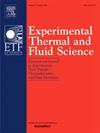超声振动下快速锡滴在不锈钢基体表面的碰撞与扩散行为
IF 2.8
2区 工程技术
Q2 ENGINEERING, MECHANICAL
Experimental Thermal and Fluid Science
Pub Date : 2025-02-26
DOI:10.1016/j.expthermflusci.2025.111447
引用次数: 0
摘要
将超声振动应用于一种新型的基于液滴的增材制造方法具有重要的前景。这是由于超声波振动能够改变液滴在底层衬底上扩散的动态动力学,从而增强润湿。本文研究了超声振动下不锈钢表面锡滴的动态特性和润湿性。我们研究了扩散直径、润湿角和凝固后宏观形貌的变化。研究结果表明,超声波振动显著促进液滴扩散,减少缩回,特别是在较高的材料温度下。膨胀过程中,发生动态润湿角振荡。凝固后,锡液滴表面呈现出更一致的波纹图案。在较低的温度下,超声波诱导的润湿性增强很小,但在较高的温度下,它显著地促进了锡滴对衬底的润湿性。这种增强归因于超声波振动对锡液滴动力学、表面和粘附能的影响,特别是在锡液滴熔点以上。超声振动可提供高达60%的初始能量,显著促进液滴润湿和扩散。我们的研究阐明了超声波在高速液滴过程中的重要性,为超声辅助液滴沉积方法提供了理论指导。本文章由计算机程序翻译,如有差异,请以英文原文为准。
Collision and spreading behavior of rapid tin droplets on stainless-steel substrate surfaces under ultrasonic vibration
Applying ultrasonic vibration in a novel droplet-based additive manufacturing method holds significant promise. This is attributed to the ability of ultrasonic vibration to alter the dynamic dynamics of droplets spreading on the underlying substrate, enhancing wetting. Our study focuses on the dynamic properties and wettability of tin droplets on a stainless-steel surface under ultrasonic vibration. We investigate changes in spreading diameter, wetting angles, and post-solidification macroscopic morphology. Findings demonstrate that ultrasonic vibration considerably promotes droplet spreading, reducing retraction, especially at higher material temperatures. During expansion, dynamic wetting angle oscillations occur. Post-solidification, the tin droplet surface exhibits a more consistent ripple pattern. At lower temperatures, ultrasonic wave-induced wettability enhancement is minimal, but at higher temperatures, it significantly boosts substrate wetting by tin droplets. This enhancement is attributed to ultrasonic vibration’s influence on droplet kinetic, surface, and adhesion energy, notably above the tin droplets’ melting point. Ultrasonic vibration, providing up to 60% of the initial energy, significantly aids droplet wetting and spreading. Our study elucidates the importance of ultrasonic waves in high-speed droplet processes, offering theoretical guidance for ultrasound-assisted droplet deposition methods.
求助全文
通过发布文献求助,成功后即可免费获取论文全文。
去求助
来源期刊

Experimental Thermal and Fluid Science
工程技术-工程:机械
CiteScore
6.70
自引率
3.10%
发文量
159
审稿时长
34 days
期刊介绍:
Experimental Thermal and Fluid Science provides a forum for research emphasizing experimental work that enhances fundamental understanding of heat transfer, thermodynamics, and fluid mechanics. In addition to the principal areas of research, the journal covers research results in related fields, including combined heat and mass transfer, flows with phase transition, micro- and nano-scale systems, multiphase flow, combustion, radiative transfer, porous media, cryogenics, turbulence, and novel experimental techniques.
 求助内容:
求助内容: 应助结果提醒方式:
应助结果提醒方式:


